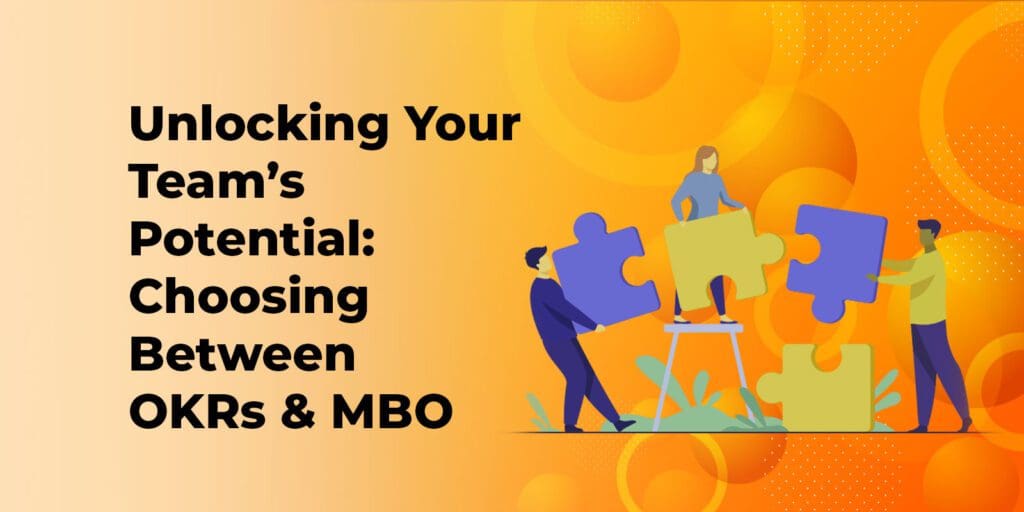Table of Contents
Battle of the Frameworks: MBOs vs. OKRs
When setting goals in an organisation, there are many methods and frameworks to choose from. Two popular goal-setting frameworks are Objectives and Key Results (OKRs) and Management by Objectives (MBOs). Both frameworks have unique benefits and drawbacks, and choosing the right one for your organisation can be challenging. This article will compare OKRs vs MBOs and help you understand which approach is better for your company.
Introduction to OKRs and MBOs
Before we dive into the differences between OKRs and MBOs, let’s define each framework.
What is Objectives and Key Results (OKRs)?
OKRs stand for Objectives and Key Results. Google popularised this framework, which many other organisations have since adopted. The OKR framework involves setting specific, measurable goals tied to the company’s objectives. The key results are the measurable outcomes that will show whether or not you have accomplished the objective, which is the purpose you are trying to achieve.
What is Management by Objectives (MBO)?
MBOs stand for Management by Objectives. Peter Drucker first presented this paradigm in his 1954 book “The Practice of Management.” The MBO approach involves setting goals for employees that are tied to the company’s overall goals. These goals are set collaboratively between the employee and the manager, and progress is monitored throughout the year.
OKRs vs MBOs – Key Differences
While both OKRs and MBOs are goal-setting frameworks, there are some key differences between the two.
Common Goal
Organisations employ MBOs as a tool to assist employees in setting annual goals. They are frequently used to help evaluate employee performance and set performance standards. Most of the time, employers put them, and employees follow those rules.
However, OKRs are utilised to define quarterly targets for the staff. OKRs are frequently used to set challenging goals and monitor achieving those objectives. They are typically strategy and alignment-focused. Employees and their employers work together to develop these objectives.
Objectives and Key Results
The main difference between OKRs and MBOs is how objectives and key results are set.
With OKRs, objectives are set first, then key results are determined based on how progress towards the objective will be measured.
With MBOs, objectives and key results are set collaboratively between the employee and the manager.
Focus
Regarding focus, the primary distinction between OKRs and MBOs is that the former is mainly concerned with results, while the latter is more concerned with activities.
MBOs prioritise establishing precise, deadline-driven goals.
A goal-setting framework known as OKRs (Objectives and Key Results) focuses on creating challenging objectives (Objectives) and then breaking those objectives down into quantifiable Key Results.
Team Discussion
OKRs are often set collaboratively between team members, while MBOs are set collaboratively between employees and managers.
Encourages Innovation
OKRs encourage innovation and experimentation, while MBOs tend to be more rigid and focused on meeting specific targets.
Tied to Compensation
OKRs are not usually tied to compensation, while MBOs often are.
Benefits of using OKRs in goal setting
There are many benefits to using the OKR approach in goal setting.


Measurable Goals
OKRs require specific, measurable goals to be set, which makes it easier to track progress and determine whether or not the goal has been achieved.
Company Goals
OKRs are tied to the company’s overall goals, ensuring everyone is working towards the same objectives.
OKR Software
Many OKR software tools are available to help organisations monitor their progress towards their objectives, ensuring that everyone is on the same page.
Achieving 100%
OKRs encourage organisations to strive for 100% achievement of their goals, which can lead to higher levels of performance and productivity.
OKR Approach
The OKR approach encourages innovation and experimentation, leading to new ideas and improvements within the organisation.
Benefits of using MBOs in goal setting
While MBOs have some drawbacks compared to OKRs, there are still some benefits to using this approach in goal setting.
MBO Approach
MBOs involve setting goals collaboratively between the employee and the manager, which can lead to better alignment and understanding of the company’s overall goals.
MBOS and OKRs
MBOs can be combined with OKRs to create a hybrid approach combining both frameworks’ benefits.
Stand for Management
MBOs stand for Management by Objectives, which emphasises the importance of goal-setting and performance management in the organisation.
Objectives are Set
MBOs require specific objectives to be set, which can help ensure that everyone is working towards the same goals.
Tied to Compensation
MBOs are often tied to compensation, which can help motivate employees to achieve their goals.
OKR vs MBO: Which approach is better for your organisation?
Your organisation’s mindset, objectives, and values will all play a role in determining which strategy is best for you. Here are some factors to consider when deciding between MBOs and OKRs.
Culture
If your organisation values innovation and experimentation, the OKR approach may be better. If your company values collaboration and teamwork, then MBOs may be a better fit.
Goals
If your organisation has short-term goals that can be achieved within a few months, then the OKR approach may be a better fit. If your company has longer-term goals that require more planning and collaboration, then MBOs may be a better fit.
Values
If your organisation values transparency and accountability, the OKR approach may be better. If your company values collaboration and alignment, MBOs may be better.
Implementing OKRs and MBOs – Tips and Best Practices
- Start with getting an understanding of the goals of your company: What do you hope to accomplish? What are your main concerns? You can start creating OKRs or MBOs that are in line with the goals of your organisation once you have a firm grasp of those objectives.
- Ensure your MBOs or OKRs are time: bound, relevant, quantifiable, realistic, and detailed. Your goals will be more attainable, meaningful, and clear.
- Ask your team members for their opinions: Getting feedback from your team members is crucial when creating your OKRs or MBOs. By doing this, you can ensure that everyone is dedicated to attaining your goals and that they align with your team’s needs.
- Tell your team about your MBOs or OKRs: It’s important to share your OKRs or MBOs with your team after you’ve created them. This will make it easier to ensure that everyone is working towards the same goals and that they all understand them.
- Follow your development and adapt as necessary: Constantly monitoring your accomplishments in relation to your MBOs or OKRs is crucial. This will enable you to spot any areas where you are lagging and make the necessary modifications.
- Celebrate your accomplishments: Celebrate your accomplishments when you reach your OKR or MBO goals. Your employees will remain engaged and motivated as a result.
Real Life Examples of Organizations that Use a Combination of OKR & MBO Strategies for Success
The debate over the effectiveness of OKRs vs MBO has been ongoing for some time. While OKRs focus on achieving measurable objectives, MBOs emphasise goal-setting and performance management. However, many successful organizations have found that combining both strategies can lead to greater success.
One such organisation is Google, which has been using OKRs since its early days. However, they also incorporate MBOs to ensure that every employee is aligned with the company’s common goal. Another example is Intel, which uses MBOs to set specific employee goals and objectives while utilising OKRs to measure progress and adjust strategies accordingly.
LinkedIn is another organisation that has found success in combining OKRs and MBOs. They use MBOs to set individual employee goals and objectives and OKRs to align those goals with the company’s overall mission. This approach has driven significant growth for LinkedIn in recent years.


While there may be a debate over the effectiveness of OKRs vs MBOs, many organizations have found that combining both can lead to greater success. By setting specific goals and objectives with MBOs and measuring progress with OKRs, organizations can ensure that everyone is aligned with the company’s common goal and working towards achieving it.
Conclusion – Choosing the right goal-setting framework for your company
In conclusion, OKRs and MBOs are effective goal-setting frameworks, and choosing the right one for your organisation depends on several factors. Consider your company’s culture, goals, and values when making your decision, and be bold and use a hybrid approach that combines the benefits of both frameworks. Remember to communicate clearly, track progress, provide training, and continuously improve your framework to ensure that it meets your organisation’s needs.
Sign up for free to execute your goal-planning strategies starting today!
FAQs
What are the drawbacks of OKR?
Challenging to track: OKRs are difficult to follow, particularly if they need to be better defined.
OKRs may be too ambitious, which might result in failure and despair.
OKRs are abstract, making it challenging to comprehend what must be done to fulfil them.
What MBO drawbacks are there?
The rigidity of MBOs may make it difficult to adapt to change.
MBOs could be unduly focused on individual employees’ performance, making it difficult for teams to collaborate.
MBOs may be too subjective, which makes it difficult to assess performance.
What framework would be best for me?
If you’re looking for a clear, aligned, focused, quantified, and agile framework, OKRs may be a suitable choice for you. If you want a simple, understandable, and accountable framework, MBOs may be a good choice for you.



